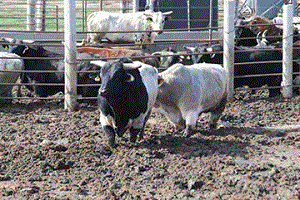By Grant Dewell
Even with little winter snow cover to melt the forecast still looks muddy for cattle producers this spring. Most areas in Iowa had significant rain in the late fall and early winter before the ground froze. With the temperature warming up early this year mud is going to persist in cattle lots and pastures throughout the spring. For spring calving operations, mud can be deadly.

Even though the temperature may be warm, calves can still get chilled easily if they can’t dry off. The ground may be thawing and warming up in the day but nighttime temperatures will still drop below freezing, so calves will need a dry place to lie down.
The main problem with mud is that pathogens that can cause calf diarrhea persist in the environment longer and mud facilitates continual exposure to the calf. If the cow has to either lay down in a wet muddy environment or walk through deep mud to get to feed or water she will contaminate her udder with mud and pathogens. The calf is then re-exposed every time they nurse. Prepare now to deal with calf diarrhea this spring. Download the free Iowa State publication "Control of Calf Diarrhea (Scours) in Midwest Beef Cattle Farms"
Mud control
The two main options available at this time for controlling mud would be to haul in rock/gravel to establish a firm base with better drainage or apply lime. Quicklime or hydrated lime will dry up the soil so that it can be compacted. After the lime is applied and allowed to dry for a few hours it should be worked into the ground and then compacted.
Bedding
With or without combating the mud in the lot, bedding is still important but needs to managed properly. Unmanaged bedding can be worse than no bedding as pathogen loads will increase and persist in bedded areas. Cornstalks are one of the most available sources and generally superior than straw or sawdust. The bulky nature of the corn stalk helps water and manure settle while the surface stays drier. If the goal is to maintain a bedded pack, apply new bedding often to keep surface dry. Calves need a drier surface than typically seen in finishing barns. If not establishing a pack, then the bedding should be completely removed and new bedding applied as soon as it becomes damp or soiled.
Move cows often
Congregating cows leads to manure, mud and more pathogens. Keep bedding areas separate from feeding area to encourage cattle to not congregate in one spot. If you have the ability move cows to new areas it will help minimize the impact of mud. A modified Sandhills calving system where you move your pregnant cows and leave pairs behind can help to decrease disease outbreaks as we move through the calving season.
Source: iastate.edu